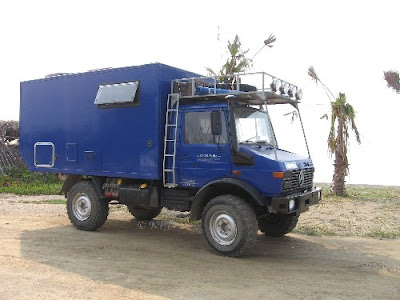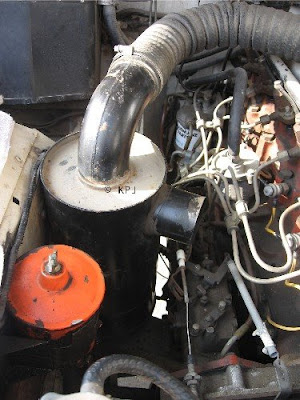
Isla Sancti Petri
We were getting sucked into staying at Tarifa. It's one of those places where time just passes. And suddenly you realise that a week or more has passed by and you have a slightly surreal existence.
Make friends, they move on, new people come, make new friends. Fortunately some noisy young people arrived and determined to party on into the middle of the night so that was a suitable incentive to clear off and find a more tranquil camp site.
We packed up - it was dry, the weather had improved, and we hit the road. We basically took the main road (N340) up through Cadiz province.
For no particular reason - it was probably lunchtime (ie Spanish lunchtime so halfway through the afternoon) - we decided to stop at Conil de la Frontera. There were little triangles on my maps so there were obviously camp sites and we cruised into town. Being practical we found a supermarket and bought a few supplies and then stopped off at a fine cheap bar for a tapas or two.
Back in the Landy we followed the signs to the campsite. It took us out of the town and along the coast and into some pine trees. Virtually all the campsites along the coast line are set in some sort of pine forest, to a greater or lesser degree.
We booked into Camping Roche and went to find a pitch. The site was pretty empty. Apparently it had only just re-opened for the season. We decided to take up two pitches - hey, why not? One for the vehicle, and one for the tent and the trailer.
We hadn't been pitched long before Mike and Mary wandered over to speak to us. They came from Yorkshire. Usually they wintered in India but this year they had borrowed somebody's brother's
We gave them a few beers. Later they gave us a few beers back and some wine. They gave us some cast-off books which I devoured in no time.
Behind us we had Gunther and Ute. They were Swiss and possessed a rather new 4x4 of some indeterminate brand (all the same to me) and a matching new caravan.
We started with Schnapps over the fence but soon ended up with wine, beer, Schnapps and olives in their caravan. We felt duty bound to finish off the dregs of our malt whisky from the Hebrides with them. (Can't remember which, but it was probably Jura or one of the Islay ones).
We developed a nice little social circuit. When we weren't socialising with the Tykes or the Swiss we were chatting with the Brasilian worker who did most of the maintenance and everything else on the site. Or the other couples in tents (there were only three tents including us).
I have no idea what this site is like now, but a few years ago - it OOZED hot water. For washing up, for washing machines, in showers - all at no extra charge. This was truly Paradise on the Costa de la Luz.
A fine social circuit and hot water too? Unbeatable. We walked the dogs along the cliff tops in the morning and the evening, and sometimes we wandered down to the wonderful beaches. And the sun came out and the weather warmed up. Very nice. We watched the Spaniards improvise with bits of plastic and twigs to make amazing sunshades, so we did the same with a groundsheet and a nearby tree.
A groundsheet for a sunshade

Conil was a nice resort. Not hugely touristy, more of a holiday destination for Spaniards than foreigners. We found our way round the shops and got sucked into staying there for over a week. The Tarifa Syndrome had struck again.
We even had time to sort the leaking hub oil seal and fit new brake shoes to the rear wheels.
Then we explored down the coast as far as the Cape of Trafalgar, admiring the absolutely stunning beaches on the way. Barbate was pretty naff looking, and on the way back, Vejer was ok but nothing special, but the unspoilt scenery was lovely.
We went inland. Gunther and Ute were visiting friends in Medina Sedonia which has loads of history and heritage so we went for a look. Seemed like another boring place but the roads around were quiet and the driving was so peaceful.
And we went up the coast as far as Sancti Petri in the Bay of Cadiz. More beautiful beaches and a guy's coche stuck in the sand.
Could we pull him out? No. Didn't think so without pulling off his plastic bumper. There was absolutely nowhere to attach a tow rope to. NB. At this point I should remind everyone that towing in Spain is illegal but we were not going to tow on the road, merely get him out of the sand. Anyway we weren't even going to do that.
So the two guys and the solid strong Spanish woman pushed the coche out. What did I do? Took photos I suppose. They didn't really need me.
Parked up to help the Spanish car out of the sand

But like Tarifa, Conil's sell-by date suddenly arrived. Easter. Or more precisely Semana Santa. Holy week. Mega holiday in Spain and half of Andalucía's noisy youth suddenly descended on Conil. We moved to a quieter spot. We even had to confine ourselves to one pitch.
Our social circuit changed. We were near some charming Germans with yet another flash motorhome. It rained and they asked if we wanted to dry out inside their flashmachine. We politely, stoically, and Britishly declined. So then they came out and assertively insisted we joined them for drinks and snacks which they had already got ready for us. They were teachers. They had a flat in Hamburg, a boat in Turkey, and the flashmachine that they travelled with through Europe. Their English was impeccable. The drinks and the snacks were good too.
But a couple of nights of rain, noise, and a cramped pitch was too much so we left. We said our goodbyes and hoped to see people again. As you do, although never expecting to.
And so we set off on Easter Saturday towards Seville, on our way to Portugal, via Cota Doñana.
Mileage for trip
Tarifa to Conil (approx) - 37 miles
Conil to Cape of Trafalgar (approx) - 28 miles
Conil to Medina Sedonia (approx) - 47 miles
Conil to Sancti Petri (approx) - 37 miles
Landy problems
Replaced hub oil seal and new brake shoes on rear wheels
Landy help
Would have towed guy stuck in sand - but pushed him out anyway


























